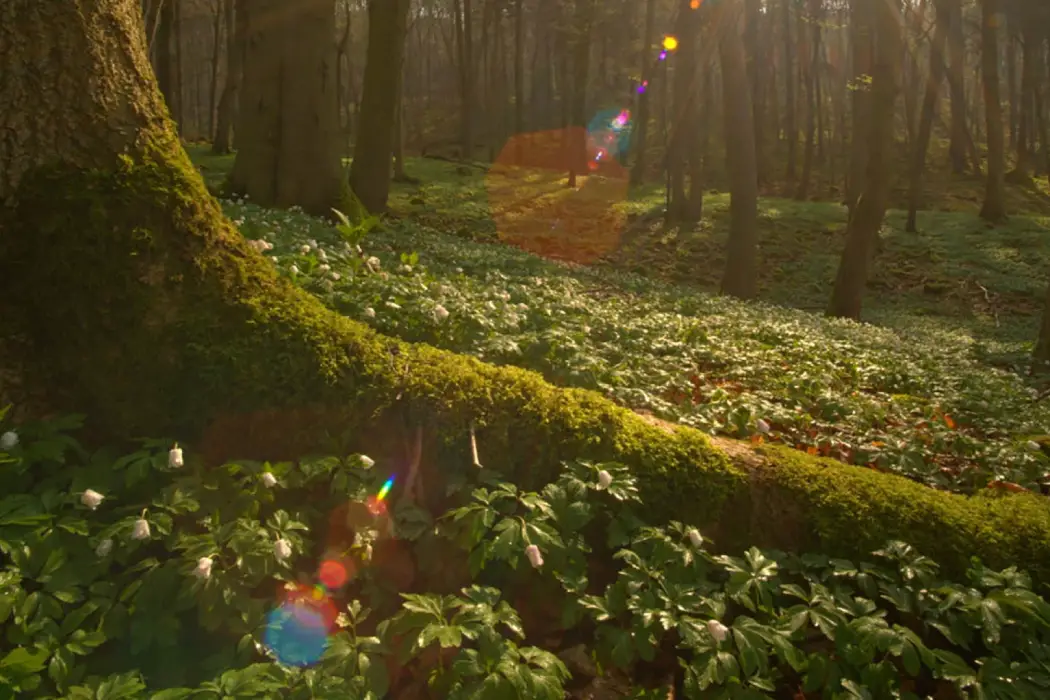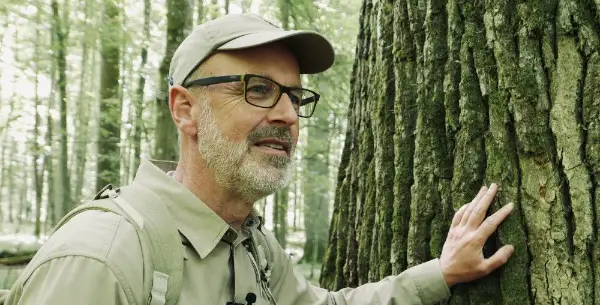THE HIDDEN LIFE OF TREES: Conservationist Peter Wohlleben Speaks for The Trees

Tynan loves nagging all his friends to watch classic movies…
I went through AP Biology in a specific era, and this makes it difficult to strip the subject away from classroom staples like Planet Earth. If you’re like me, you equate the gorgeous imagery of nature documentaries with the smoky, slightly erudite voice of David Attenborough.
Although The Hidden Life of Trees has its own version of an omnipresent narrator, it is the world-renowned Peter Wohlleben who becomes the crucial figure in defining the film’s ethos. He’s the film’s conservationist rock star: knowledgeable from lifelong research but equally personable, communicating his findings to adults and children alike.
We rarely get a full explanation into his various forays and yet we see him globetrotting the world to any number of forests, book signings, and environmentalist events. He’s less of a forester and more of a modern-day Lorax – educating the general public and speaking for the trees – because as you already know, the worlds of Tolkien and Lewis notwithstanding, trees cannot speak for themselves.

However, this documentary makes it very clear that trees are very much alive, active and working at their own pace. Speeding along as we do in modern civilization, we often miss just how phenomenal they really are. Hence The Hidden Life of Trees. Moment by moment, through time-lapse and explanations put in layman’s terms, the documentary endeavors to pull back the veil so we might appreciate these living creatures in a new light.
United We Stand, Divided We Fall
Far from simply existing as a few more cogs in the survival of the fittest or being a matter of commensalism or parasitic behaviors, trees rely on a great deal of interdependence. They undertake vast amounts of nutrient exchanges; helping neighbors in need seems to be the rule, not the exception, with forests acting as superorganisms. The old take care of the young and vice versa, almost like human beings…
And like humans, trees are considered here as social beings though we probably rarely think of them in such terms. It takes some getting used to as the film continues to refer to them in almost anthropomorphic terms. They help each other in these very tangible ways even if we don’t see them instantaneously with the naked eye. It takes the passage of time (or high-speed cameras).
An infestation of marauding bugs triggers mechanisms and a cry for help. They team up with fungi, which transfer signals from tree to tree (ie. wood-wide web). And of course, there’s decomposition. The dead remains of some trees feed their children in a never-ending cycle. Here bugs and fungi both help, acting as the terrestrial plankton, aiding in this large-scale recycling process. Trees also have a sense of time, shedding their leaves in a very precise rhythm and giving us the seasonal changes we now accept as second nature.
If these are some of the nitty-gritty factoids behind the project, then, it’s safe to say The Hidden Life of Trees is generally a laidback experience. Still, although it’s hardly alarmist, it doesn’t mince words when it comes to what is beneficial and detrimental to the forest.

Chainsaws are a no-go. Technology like drones can be used to pinpoint areas infested by bark beetles needing to be removed. But Wohlleben also dispels some myths. Nature is not about rapid excess. In fact, on nature reserves things are slowed down – not overgrown – this feels like their natural progression, leaving them totally untouched by man.
And although selective logging in places like British Columbia means a more tedious process, driving up costs, it’s also the way to greater more fruitful conservation for a sustainable future. In order to harness our forests in the battles for climate change, they must be allowed to grow old, pure, and simple.
Conclusion: The Hidden Life of Trees
My major takeaway is the immeasurable amount we can still learn about trees and how they function in so many capacities. It’s a documentary full of subtle, quiet moments, reminding us that a liberal dose of wonder is something quite powerful. Rather than taking nature for granted, it makes us appreciate it all the more for its many intricacies.
There are bits and pieces here for us to follow, but they also feel unfinished. It’s so broad, touching on so many things, it can seem daunting. Especially as a neophyte, it feels like there’s still so much to know, so much more work to be done, and after this documentary, I’m left feeling like we need even more guidance.
It’s only a thought but like many of the revelatory documentaries that have come before, The Hidden Life of Trees could have been aided by more installments. It can stand alone as a quiet meditation on our arboreal neighbors, but a series that could radiate out and enmesh itself in the soil of its many topics could go a long way. For now, I’m contented with what we got, and I hope that as Peter Wohlleben continues to speak for the trees, more people listen. He may not have a voice like David Attenborough, but I’m still apt to lend him an ear.
What do you find most rewarding about nature documentaries? Please let us know in the comments below!
Watch The Hidden Life of Trees
Does content like this matter to you?
Become a Member and support film journalism. Unlock access to all of Film Inquiry`s great articles. Join a community of like-minded readers who are passionate about cinema - get access to our private members Network, give back to independent filmmakers, and more.
Tynan loves nagging all his friends to watch classic movies with him. Follow his frequent musings at Film Inquiry and on his blog 4 Star Films. Soli Deo Gloria.













